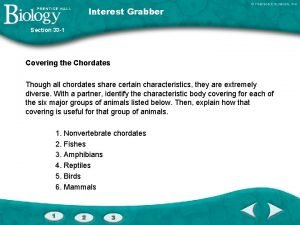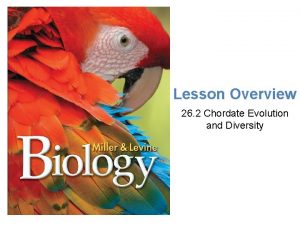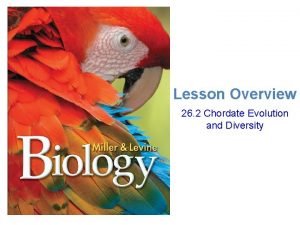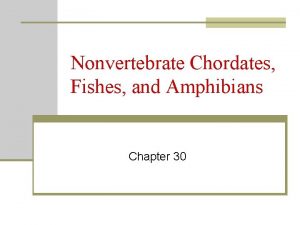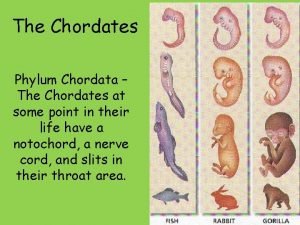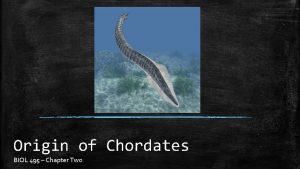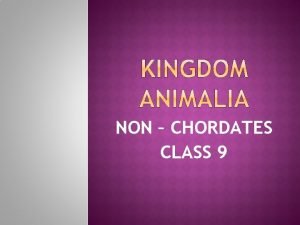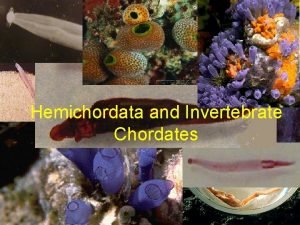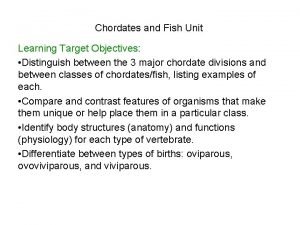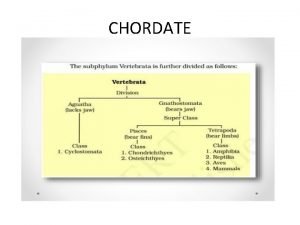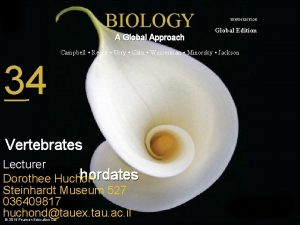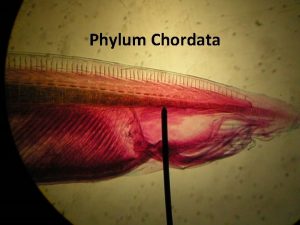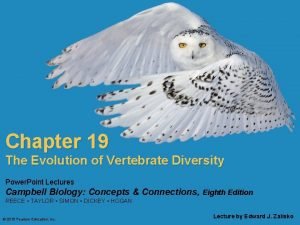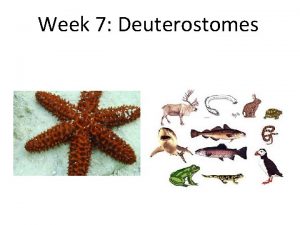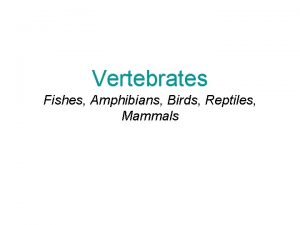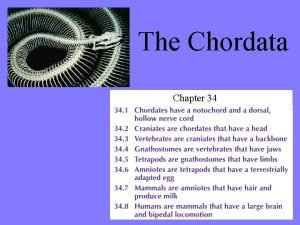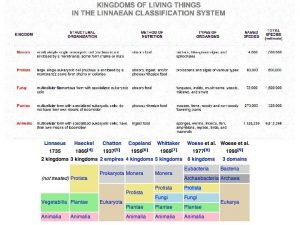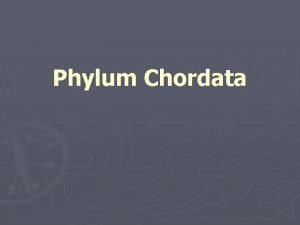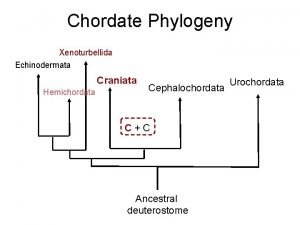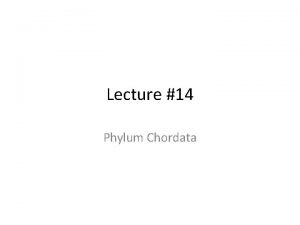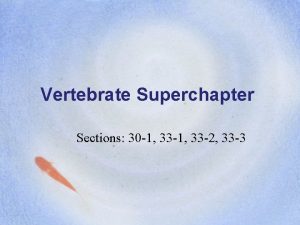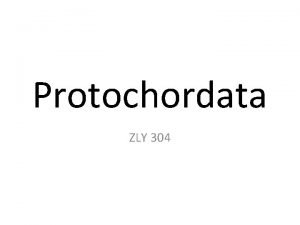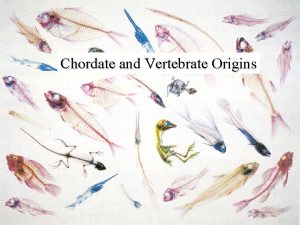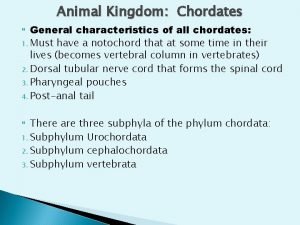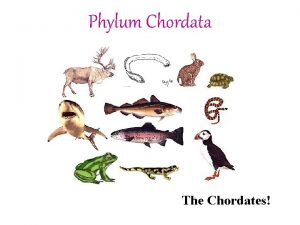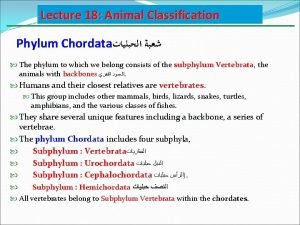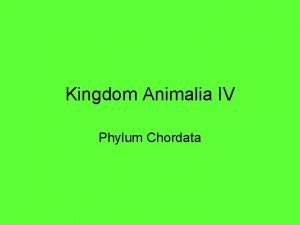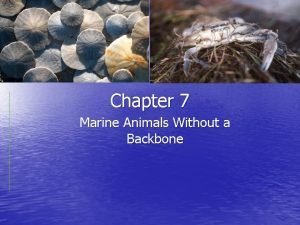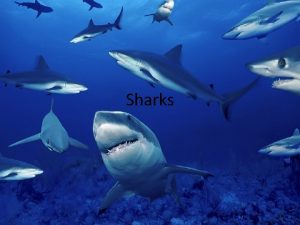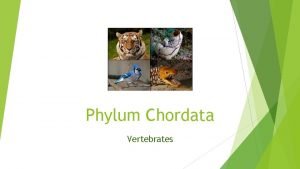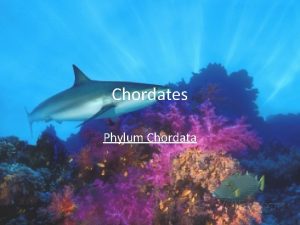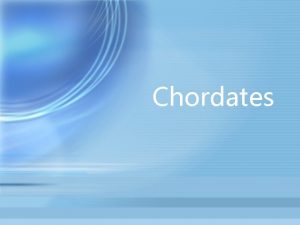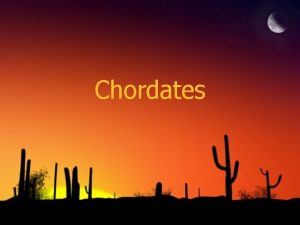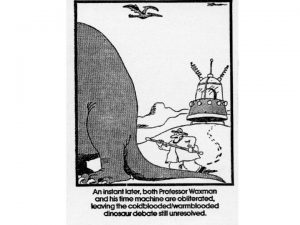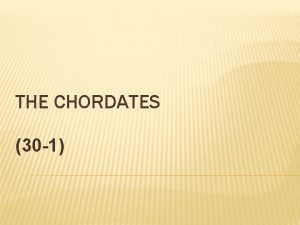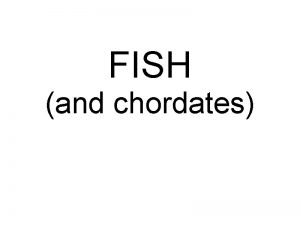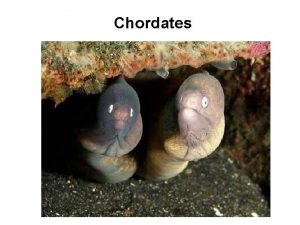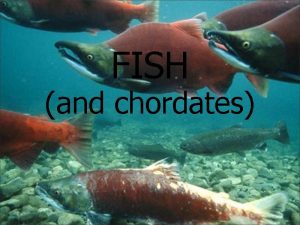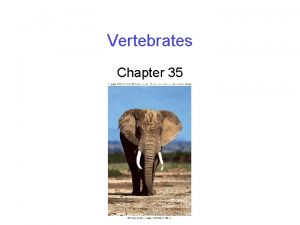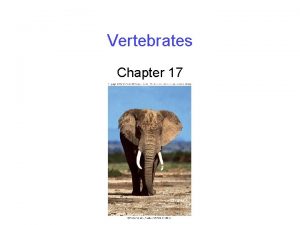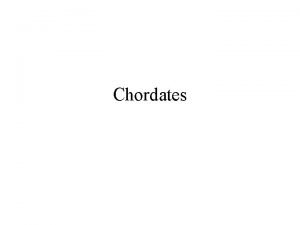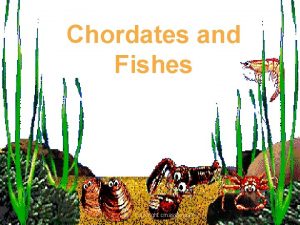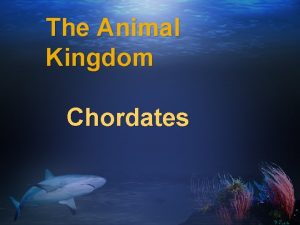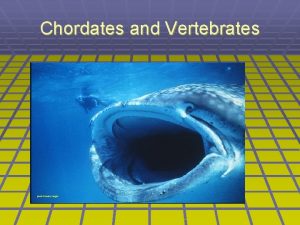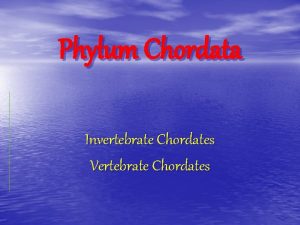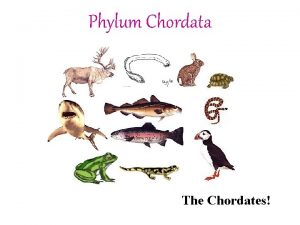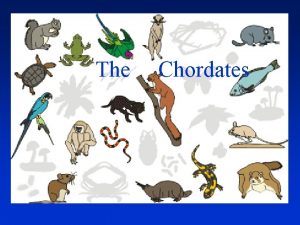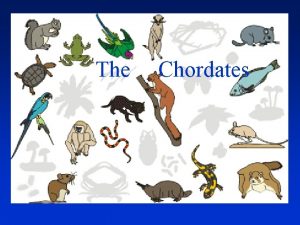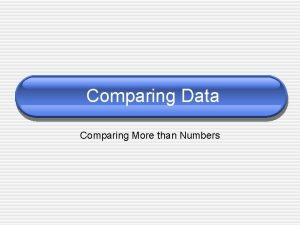Comparing Chordates Chapter 33 33 1 Chordate Evolution






























- Slides: 30

Comparing Chordates Chapter 33

33 -1 Chordate Evolution • First appeared 500 mya • Most ancient were related to the echinoderms (starfish) • Fossils present in Cambrian deposits of Burgess Shale • Most ancient relative found so far is Pikaia, like a worm with a notochord, only found in Chordates column and pairs of muscles like invertebrates

Pikaia, early Chordate

33 -1 Chordate Family Tree

33 -1 Evolutionary Trends • Good fossil record! • Adaptive radiation-Appearance of new adaptations (jaws, paired appendages) launch rapid diversification of species as they adapt to new conditions • Convergent evolation-sometimes species evolve that are similar in appearance and behavior even though they are not closely related (example birds and bats both fly)

33 -1 Chordate Diversity • 6 living groups of chordates – Non-vertebrate chordates – Fishes – Amphibians – Reptiles – Birds – Mammals

33 -1 Chordate Diversity

33 -2 Controlling Body Temperature • Important for maintaining homeostasis • Enzymes and other proteins work best within a certain range of temperatures • All ways of maintaining body temp incorporate – A source of heat for the body – A way to conserve heat – A way to eliminate excess heat

33 -2 Controlling Body Temperature • Ectothermy-body temp mainly determined by the environment. Reptiles, fishes, amphibians – Warm up in sun, cool down by burrowing. – Low metabolic rate, muscles generate heat but no insulation •

33 -2 Controlling Body Temperature • Endothermy-generate and retain heat inside their bodies. Body temp controlled from within. Birds and mammals. – Have insulation like body fat, hair, feathers – Sweat or pant to remove excess heat – High metabolic rate, generate lots of heat

33 -2 Controlling Body Temperature • Ecto- vs Endotherms • Endotherms can stay warm at night and during cold weather but require a lot of food to generate heat • Ectotherms are more energy efficient in climates that stay warm and have fairly constant temps but take a long time to warm up in cold climates

33 -2 Controlling Body Temperature • Evolution of temperature control • First land animals were ectoderms • Reptiles are ectotherms but dinosaurs may have been endotherms • Endothermy may have evolved more than once – Along the evolutionary line when reptiles evolved into birds – Along the evolutionary line when reptiles evolved into mammals

33 -3 Form and Function in Chordates • Feeding • Non-vertebrate chordates (tunicates, lancelets) are filter feeders – Remove plankton from water in pharynx • Skulls and teeth of vertebrates are adapted to feed on wide variety of foods – Insects, meat, seeds, nuts, leaves, nectar, etc. – Some vertebrates (Baleen whales) are filter feeders which strain food in their mouths

33 -3 Form and Function in Chordates • Digestive systems • Organs are well adapted for different feeding habits • Carnivores have short digestive tracts that produce fast acting meat digesting enzymes • Herbivores have long digestive tracts that have bacteria that produce plant digesting enzymes

33 -3 Form and Function in Chordates

33 -3 Form and Function in Chordates Respiration Aquatic animals have gills Land animals have lungs Both allow for gas exchange Some fish have extra respiratory organs-air sacs • Lancelets and sea snakes, amphibians also respire by diffusion across body surfaces • • •

33 -3 Form and Function in Chordates • Respiration (continued) • Gills-water flows over, gas exchanged. Oxygen goes into capillaries, carbon dioxide diffuses into water • Lungs-Oxygen and carbon dioxide exchanged • Surface area in mammals greater than in amphibians • Amphibian lungs sacs with ridges • Reptile lungs have small chambers • Mammals have alveoli, oxygen rich and poor air move in and out through same passage, always oxygen poor air trapped in lungs • Birds have one way air flow so always have fresh oxygen, allows flight at high altitudes

33 -3 Form and Function in Chordates • Gills

33 -3 Form and Function in Chordates

33 -3 Form and Function in Chordates

33 -3 Form and Function in Chordates • Circulation • Lancelets and tunicates have short tubelike hearts with a simple pump, no true chambers in heart or no true heart • Single loop circulation-animals that have gills – Blood moves from heart to gills to body to heart • Double loop circulation-animals that have lungs – Blood moves from heart to lungs to heart to body to heart

33 -3 Form and Function in Chordates • Heart Chambers • Partitions evolved that separate oxygen rich and poor blood • Fish-2 chambers, one atrium, 1 ventricle, some mixing of blood • Most reptiles-3 chambers, 2 atria, 1 ventricle with partial division, some mixing of blood • Crocs, birds, mammals-2 atria, 2 ventricles, no mixing of blood

33 -3 Form and Function in Chordates

33 -3 Form and Function in Chordates • Excretion • Ammonia must be eliminated or converted to urea • Tunicates-ammonia leaves through outflow siphons • Vertebrates-kidneys – Aquatic amphibians and most fish also excrete ammonia through gills – Land animals-urea or uric acid excreted by kidneys – Also maintain water and salt levels

33 -3 Form and Function in Chordates • Response • Non-vertebrate chordates have simple nervous systems with a mass of neurons that form the brain – No specialized sensory organs but may have sensory cells • Vertebrates have complex brains with regions that perform different functions – Cephalization of sense organs and neurons

33 -3 Form and Function in Chordates

33 -3 Form and Function in Chordates • Movement • Non-vertebrates lack bones but have muscle, use muscle contraction or water flow to move • Vertebrates have skeletal and muscular systems internal skeletons (except hag fish) – Bones or cartilage – Backbone with vertebrae – Limb girdles that appendages attach to

33 -3 Form and Function in Chordates

33 -3 Form and Function in Chordates Reproduction Almost all reproduce sexually Trend is from external to internal fertilization Oviparous- fertilized egg develops outside body Ovoviviparous-fertilized egg develops inside body, nutrients from yolk in egg, young born alive • Viviparous-fertilized egg develops inside body, nutrients directly from mother, young born alive • • •

33 -3 Form and Function in Chordates
 Section 33-1 chordate evolution answer key
Section 33-1 chordate evolution answer key Chordata cladogram
Chordata cladogram Lesson 6: chordate evolution and diversity
Lesson 6: chordate evolution and diversity Chordata
Chordata Non vertebrate chordates
Non vertebrate chordates What are the four main characteristics of chordates
What are the four main characteristics of chordates Ancestor of chordates
Ancestor of chordates Pariplaneta
Pariplaneta Class pterobranchia
Class pterobranchia Brain fish
Brain fish Chordata shark
Chordata shark Chordate
Chordate Notochord chordates
Notochord chordates Chegg
Chegg Deuterostomes vs protostomes
Deuterostomes vs protostomes Choradate
Choradate Shark chapter 34
Shark chapter 34 Chordate subkingdom
Chordate subkingdom What are chordate characteristics
What are chordate characteristics Craniata
Craniata Amphioxus characteristics
Amphioxus characteristics Section 30-1 the chordates answer key
Section 30-1 the chordates answer key Protochordates are exclusively marine and include
Protochordates are exclusively marine and include Protochordates and chordates
Protochordates and chordates What are the features of chordates
What are the features of chordates Chordata images
Chordata images Classification of chordates
Classification of chordates What are chordata
What are chordata Marine animals without backbone
Marine animals without backbone Phylum of sharks
Phylum of sharks Chordates with bodies covered with feathers.
Chordates with bodies covered with feathers.
